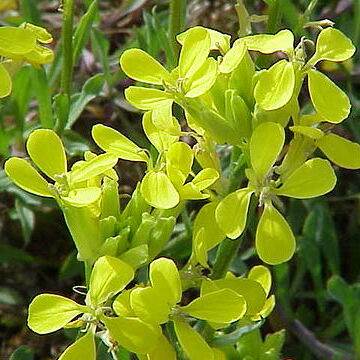Herbs annual, biennial, or perennial, rarely subshrubs or shrubs. Trichomes sessile, medifixed, appressed, malpighiaceous or 3-5(-8)-rayed stellate. Stems simple or branched basally and/or apically. Basal leaves petiolate, rosulate, simple, entire or dentate, rarely pinnatifid or pinnatisect. Cauline leaves petiolate or sessile, cuneate or attenuate at base, rarely auriculate, entire or dentate. Racemes ebracteate or basally bracteate, rarely bracteate throughout, corymbose, elongated or not in fruit. Fruiting pedicels slender or thickened and nearly as wide as fruit, erect, ascending, divaricate, or reflexed. Sepals oblong or linear, erect, pubescent, base of lateral pair saccate or not. Petals yellow or orange, rarely white, pink, purple, or violet; blade suborbicular, obovate, spatulate, or oblong, apex rounded or emarginate; claw differentiated from blade, subequaling or longer than sepals. Stamens 6, erect, tetradynamous; anthers oblong or linear. Nectar glands 1, 2, or 4, distinct or confluent and subtending bases of all stamens; median glands present or absent. Ovules 15-100 per ovary. Fruit dehiscent siliques or rarely silicles, linear or rarely oblong, terete, 4-angled, latiseptate, or angustiseptate, sessile or rarely shortly stipitate; valves with an obscure to prominent midvein, pubescent on outside, rarely also on inside, keeled or not, smooth or torulose; replum rounded; septum complete, membranous, translucent or opaque, veinless; style obsolete or short, rarely half as long as or subequaling fruit, often pubescent; stigma capitate, entire or 2-lobed. Seeds uniseriate or rarely biseriate, winged, margined, or wingless, oblong, plump or flattened; seed coat minutely reticulate, mucilaginous when wetted; cotyledons incumbent or rarely accumbent.
Sep erect or connivent, often saccate at base, the outer often minutely appendaged at apex; pet in our spp. yellow to orange, obovate or spatulate, abruptly or gradually narrowed to a long claw; short stamens subtended by a semicircular or annular gland; each pair of long stamens also subtended by a gland; anthers linear-oblong; ovary linear-cylindric, hairy; ovules numerous; style very short; stigma capitate, 2-lobed; frs elongate, ± 4-angled, hairy, the valves with a prominent midnerve; seeds in one row; herbs with narrow, entire to pinnatifid lvs, ± pubescent with appressed, 2–5(–7)-pronged hairs. All our spp. are ± densely pubescent on the stem, lvs, sep, and fr, and even on the back of the pet, especially at the base of the blade. 200, N. Temp.
Annual to perennial taprooted herbs. Hairs branched, medifixed or stellate. Stems erect, leafy. Lvs simple, toothed to pinnatifid. Racemes ebracteate, often ± corymbose. Sepals erect, the inner usually saccate, the outer often horned at apex. Petals yellow or purple. Stamens 6, without appendages. Lateral nectaries 4, median 2, between stamen bases. Style up to (⅓) valve length; stigma capitate or slightly 2-lobed. Silique linear to narrow-oblong, dehiscent; valves 1-veined; beak 0. Seeds oblong, sometimes winged, in 1 row per locule.
Annual herbs with branched, appressed hairs. Sepals erect, usually dimorphic. Petals long-clawed. Stamens 6. Median nectariferous glands present. Stigma capitate, slightly bilobed. Siliqua dehiscent, quadrangular; midvein conspicuous. Seeds in 1 row per locule. Radicle incumbent.

